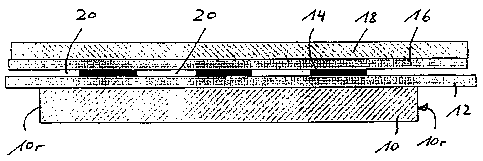Une partie des informations de ce site Web a été fournie par des sources externes. Le gouvernement du Canada n'assume aucune responsabilité concernant la précision, l'actualité ou la fiabilité des informations fournies par les sources externes. Les utilisateurs qui désirent employer cette information devraient consulter directement la source des informations. Le contenu fourni par les sources externes n'est pas assujetti aux exigences sur les langues officielles, la protection des renseignements personnels et l'accessibilité.
L'apparition de différences dans le texte et l'image des Revendications et de l'Abrégé dépend du moment auquel le document est publié. Les textes des Revendications et de l'Abrégé sont affichés :
| (12) Demande de brevet: | (11) CA 2714810 |
|---|---|
| (54) Titre français: | MODULE PHOTOVOLTAIQUE |
| (54) Titre anglais: | PHOTOVOLTAIC MODULE |
| Statut: | Réputée abandonnée et au-delà du délai pour le rétablissement - en attente de la réponse à l’avis de communication rejetée |
| (51) Classification internationale des brevets (CIB): |
|
|---|---|
| (72) Inventeurs : |
|
| (73) Titulaires : |
|
| (71) Demandeurs : |
|
| (74) Agent: | NORTON ROSE FULBRIGHT CANADA LLP/S.E.N.C.R.L., S.R.L. |
| (74) Co-agent: | |
| (45) Délivré: | |
| (22) Date de dépôt: | 2010-09-14 |
| (41) Mise à la disponibilité du public: | 2011-06-17 |
| Requête d'examen: | 2011-02-11 |
| Licence disponible: | S.O. |
| Cédé au domaine public: | S.O. |
| (25) Langue des documents déposés: | Anglais |
| Traité de coopération en matière de brevets (PCT): | Non |
|---|
| (30) Données de priorité de la demande: | ||||||
|---|---|---|---|---|---|---|
|
The invention concerns a photovoltaic module with a transparent cover,
that forms a first main surface of the module, a protective layer, that
runs parallel and with a distance to the cover and forms a second main
surface of the module, a first adhesive layer between the cover and a
photovoltaic layer formed from a multitude of cells, a second adhesive
layer between the protective layer and the photovoltaic layer, wherein
the first and second adhesive layer are extending into an area between
the cells of the photovoltaic layer and around the cells and are projecting
the module circumferentially at the edge by 0,1 to 3 mm.
Note : Les revendications sont présentées dans la langue officielle dans laquelle elles ont été soumises.
Note : Les descriptions sont présentées dans la langue officielle dans laquelle elles ont été soumises.

2024-08-01 : Dans le cadre de la transition vers les Brevets de nouvelle génération (BNG), la base de données sur les brevets canadiens (BDBC) contient désormais un Historique d'événement plus détaillé, qui reproduit le Journal des événements de notre nouvelle solution interne.
Veuillez noter que les événements débutant par « Inactive : » se réfèrent à des événements qui ne sont plus utilisés dans notre nouvelle solution interne.
Pour une meilleure compréhension de l'état de la demande ou brevet qui figure sur cette page, la rubrique Mise en garde , et les descriptions de Brevet , Historique d'événement , Taxes périodiques et Historique des paiements devraient être consultées.
| Description | Date |
|---|---|
| Inactive : Morte - Taxe finale impayée | 2014-07-10 |
| Demande non rétablie avant l'échéance | 2014-07-10 |
| Inactive : CIB enlevée | 2014-05-22 |
| Inactive : CIB en 1re position | 2014-05-22 |
| Inactive : CIB attribuée | 2014-05-22 |
| Inactive : CIB expirée | 2014-01-01 |
| Inactive : CIB enlevée | 2013-12-31 |
| Réputée abandonnée - omission de répondre à un avis sur les taxes pour le maintien en état | 2013-09-16 |
| Réputée abandonnée - les conditions pour l'octroi - jugée non conforme | 2013-07-10 |
| Un avis d'acceptation est envoyé | 2013-01-10 |
| Lettre envoyée | 2013-01-10 |
| Un avis d'acceptation est envoyé | 2013-01-10 |
| Inactive : Approuvée aux fins d'acceptation (AFA) | 2012-12-05 |
| Demande publiée (accessible au public) | 2011-06-17 |
| Inactive : Page couverture publiée | 2011-06-16 |
| Lettre envoyée | 2011-02-23 |
| Inactive : Lettre officielle | 2011-02-22 |
| Exigences pour une requête d'examen - jugée conforme | 2011-02-11 |
| Toutes les exigences pour l'examen - jugée conforme | 2011-02-11 |
| Requête d'examen reçue | 2011-02-11 |
| Inactive : Correspondance - Formalités | 2011-01-26 |
| Inactive : CIB attribuée | 2010-10-21 |
| Inactive : CIB en 1re position | 2010-10-21 |
| Inactive : CIB attribuée | 2010-10-21 |
| Inactive : Certificat de dépôt - Sans RE (Anglais) | 2010-10-05 |
| Exigences de dépôt - jugé conforme | 2010-10-05 |
| Lettre envoyée | 2010-10-05 |
| Demande reçue - nationale ordinaire | 2010-10-05 |
| Date d'abandonnement | Raison | Date de rétablissement |
|---|---|---|
| 2013-09-16 | ||
| 2013-07-10 |
Le dernier paiement a été reçu le 2012-09-05
Avis : Si le paiement en totalité n'a pas été reçu au plus tard à la date indiquée, une taxe supplémentaire peut être imposée, soit une des taxes suivantes :
Veuillez vous référer à la page web des taxes sur les brevets de l'OPIC pour voir tous les montants actuels des taxes.
| Type de taxes | Anniversaire | Échéance | Date payée |
|---|---|---|---|
| Taxe pour le dépôt - générale | 2010-09-14 | ||
| Enregistrement d'un document | 2010-09-14 | ||
| Requête d'examen - générale | 2011-02-11 | ||
| TM (demande, 2e anniv.) - générale | 02 | 2012-09-14 | 2012-09-05 |
Les titulaires actuels et antérieures au dossier sont affichés en ordre alphabétique.
| Titulaires actuels au dossier |
|---|
| KIOTO PHOTOVOLTAICS GMBH |
| Titulaires antérieures au dossier |
|---|
| ARMIN KOGLER |
| INGRAM EUSCH |
| RUDOLF FRANK |